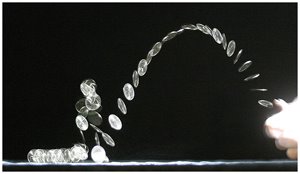The Uncertainty Principal of Architectural Theory
 Last fall, Jeff Kipnis presented a chapter from his upcoming book at Columbia’s Graduate School of Architecture Planning and Preservation. The thrust of the presentation involved three different readings of the Maison Domino diagram, and the continuing interpretation today. The following is a transcription DYWSC? has made from Mark Wigley’s introduction of Mr. Kipnis. It presents an interesting, tangled little knot of thought…
Last fall, Jeff Kipnis presented a chapter from his upcoming book at Columbia’s Graduate School of Architecture Planning and Preservation. The thrust of the presentation involved three different readings of the Maison Domino diagram, and the continuing interpretation today. The following is a transcription DYWSC? has made from Mark Wigley’s introduction of Mr. Kipnis. It presents an interesting, tangled little knot of thought…[Mark speaking of his early 80’s befriending of people like Peter Eisenman and Jeff Kipnis at a time of intense debate.] That’s the beginning of denouncing architectural theory. If anyone should be blamed for that, it is surely Peter [Eisenman]. Referring to him twice [in this introduction] gives you a sense of the meaning of a particular moment of time. [To this] group of people, the architect was first and foremost an intellectual, that is to say a theorist. Therefore, to theorize was to be an architect.The underlying assumptions of these comments speak to the location of soul of architecture. Mr. Wigley implies that in order to understand something entirely one must be removed from it. One must observe all its facets or dimensions. Similarly, sympathizing or empathizing with events inherently implies separation from the events that one observes.
That little translation had occurred at that time. For the first time perhaps there was a generation of people who were architects who never produced buildings, but never regarded themselves as being at any distance from architecture; in fact carrying out architecture in a sense more directly.
That generation was born in friendship and debate, and immediately that spurned a discussion about the possible futures of architecture in the hands of these people. Sadly, the controversy has died now. And all of those people that were such close friends at that time have established themselves and have become monuments that have to be attacked by other generations. We have already been through that.
[...] If an architect is a kind of a theorist, if a person devotes himself to theory and nothing but theory, and feels in so doing that they get to the intimate heart of architectural production (as distinct from moving away from it) these people may be even closer to the heart of the architect than the architects can be of themselves. One could argue that if an architect could theorize their own work to the same degree that scholars theorize their own work, then work would simply stop. So in a sense, a theorist of architecture may be able to become more intimate with the very thing that they don’t do -- to produce buildings. I think Jeffrey in every way exemplifies that.
(I don’t mean this in an arrogant way, as a sort of arrogance of the scholar, but something much more modest.) Precisely those who do not practice are able to slip beneath the inhibitions of the practicing architect, to locate what it is that the architect treasures the most, but could never speak of directly for fear of killing that practice that they’re involved in.
If you’re a really good architect, you may not know what it is that you do. In the same way it may be of the architectural theorist. In the end it may be that the architectural theorist doesn’t exactly know the nature of architectural theory. [...]
This is disturbing because it presents a barrier between architects and Architecture. With such an unnerving conclusion, could there be a hole in this logic? Perhaps there is one place. These observations require readers to believe that such a separation exists; what if it couldn’t?
Consider betting on a coin toss. In order to win, one must not comment on the coin, but instead on its state. In saying “Heads” or “Tails” one is commenting on the final orientation of randomly tossed coin. Acknowledging Mr. Wigley’s point, that Architecture is both theory and practice, aren’t architects required to do both to succeed? Could these be the two sides of the same coin? In order to make any design decision, we should have a construct of how design works, how buildings come to carry information, or how people read buildings. Without a bias or idea, how are descisions made?
The way we communicate could be drawing an artificial line here. When Louis Kahn asked, “And if you think of Brick, for instance, and you say to Brick, ‘What do you want Brick?’” he could have answered it in two distinct ways. If he spoke or wrote, answering with words, that activity would have a label. If he drew or built to illustrate his ideas, that activity would have a different label.
As Peter Eisenman once said at a jury “Architecture is always on the boards,” and elsewhere, “Architecture only exists as it displaces itself," meaning that Architecture’s soul is in the discussion, not the body of amassed work. In this way, it is hard to privilege on perspective from another, and harder still to differentiate between them. It is always becoming.

3 Comments:
This post is oddly circular, did you mean that?
Where did you get this text?
Dear Blite et al,
I transcribed the text from a recording. It was nice to attend even without being there, the the GSAPP is great about recording their events.
I think the topic's circularity is a problem. The attack is on the arguements construction though, and I think it should be more closely analyzed. I saw that as a big fan of Mr. Wiggly's intro; that's why I wrote it down.
Post a Comment
<< Home